
Quillaja saponaria, the soap bark tree or soapbark, is an evergreen tree in the family Quillajaceae, native to warm temperate central Chile. In Chile it occurs from 32 to 40° South Latitude approximately and at up to 2000 m (6500 ft) above sea level. It can grow to 15–20 m (50–65 ft) in height. The tree has thick, dark bark; smooth, leathery, shiny, oval evergreen leaves 3–5 cm long; white star-shaped flowers 15 mm diameter borne in dense corymbs; and a dry fruit with five follicles each containing 10–20 seeds. The tree has several practical and commercial uses.

Nothofagus pumilio, the lenga beech, is a deciduous tree or shrub in the Nothofagaceae family that is native to the southern Andes range, in the temperate forests of Chile and Argentina to Tierra del Fuego, from 35° to 56° South latitude. This tree is in the same genus as the coihue. It regenerates easily after fires. The wood is of good quality, moderate durability, and is easy to work with. It is used in furniture, shingles and construction and sometimes as a substitute for American black cherry in the manufacturing of cabinets.

Avellanita is a monotypic plant genus of the family Euphorbiaceae. The sole species is Avellanita bustillosii, endemic to Chile. A specific locus of occurrence is in the La Campana National Park of central Chile and amid the adjoining Cerro La Campana and in the Laguna Aculeo area and its southern distribution is located in Chancon, close to Rancagua. Regarding the use of its seeds, it has been pointed out that its "small hazelnuts" are edible.

Jubaea is a genus of palms with one species, Jubaea chilensis, commonly known in English as the Chilean wine palm or Chile cocopalm, and palma chilena in Spanish. It is native to southwestern South America and is endemic to a small area of central Chile between 32°S and 35°S in southern Coquimbo, Valparaíso, Santiago, O'Higgins, and northern Maule regions.

The Maule river or Río Maule is one of the most important rivers of Chile. It is inextricably linked to the country's pre-Hispanic (Inca) times, the country's conquest, colonial period, wars of Independence, modern history, agriculture, culture, religion, economy and politics. The Maule River marked the southern limits of the Inca Empire. Many famous men and women in Chile's history have been born in the Region named after the river. The river has also lent its name to one of the viticultural regions of the country, the Valley of Maule, a subregion of the Central Valley.

La Campana National Park is in the Cordillera de la Costa, Quillota Province, in the Valparaíso Region of Chile. La Campana National Park and the Vizcachas Mountains lie northwest of Santiago. This national park covers approximately 80 square kilometres (31 sq mi) and is home to one of the last palm forests of Jubaea chilensis, which prehistorically had a much wider distribution than at present. Another attraction is the Cerro La Campana, which lends its name to the park. In 1834 Charles Darwin climbed this mountain, during the second voyage of HMS Beagle.
La Campana-Peñuelas is a Biosphere Reserve located in west-central Chile, the La Campana-Peñuelas Biosphere Reserve encompasses the La Campana National Park and the Lago Peñuelas National Reserve. Forests within the La Campana-Peñuelas are habitats for the Chilean Wine Palm, Jubaea chilensis, an endangered palm, which had a much broader distribution prior to modern times.

The Cordillera Darwin is an extensive mountain range mantled by an ice field that is located in Chile.

Maytenus boaria (mayten) is an evergreen tree of the family Celastraceae, native from South America, up to 20 m (66 ft), 80 cm (31 in) diameter, straight trunk. It occurs naturally approximately from 30 to 50°S: Chile.
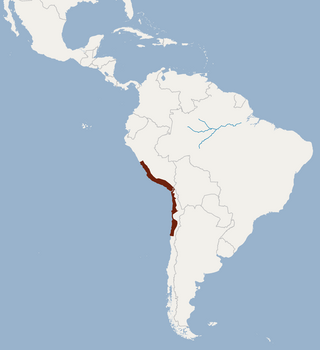
The Atacama myotis is a species of vesper bat in the family Vespertilionidae. It is found in Chile and Peru, an example ecoregion of occurrence being the Chilean matorral.
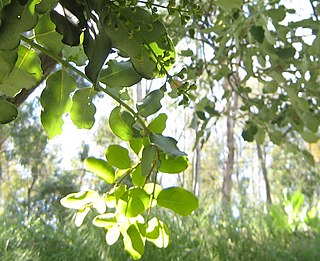
Beilschmiedia miersii, commonly known as the northern acorn tree, is a species of evergreen tree in the family Lauraceae. It is native to central Chile from 30 to 35°S., up to 1200 meters (4000 ft) above sea level and lives under very dry conditions.

Kageneckia oblonga is a species of plant in the family Rosaceae. It is endemic to Chile. K. oblonga is an evergreen tree. It grows from Coquimbo to Malleco. Example occurrences are found specifically found in central Chile within the La Campana National Park and Cerro La Campana forest areas. In these areas the endangered Chilean Wine Palm, Jubaea chilensis is an associated tree species.
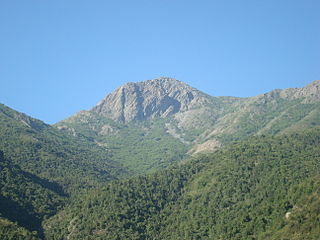
Cerro la Campana, the Bell mountain, is a mountain in La Campana National Park in central Chile. The Pacific and the mountain Aconcagua are visible from the summit on clear days.
The Vizcachas Mountains is a mountain range northwest of Santiago, in the Santiago Metropolitan Region, Chile. It is part of the Chilean Coast Ranges System.
The Ocoa Valley is a landform in central Chile located by the La Campana National Park. This valley is a locus where considerable archaeological recovery has taken place, yielding considerable finds of pre-European contact period. According to Dallman and Hogan, some of the greatest stands of the endangered Chilean Wine Palm, Jubaea chilensis are found on the slopes of La Campana that rise up from the Ocoa Valley.
Puya coquimbensis is a species in the family Bromeliaceae. This species is a rare plant found in certain portions of Chile including Punta Teatinos and Cerro La Campana. In La Campana National Park P.coquimbensis is associated with the endangered Chilean Wine Palm, Jubaea chilensis, which palm prehistorically had a much wider distribution.
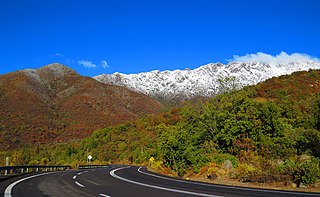
Cuesta La Dormida is a mountain in central Chile. Some of the forested mountain area of Cuesta La Dormida has been added to the La Campana National Park in order to achieve protection for the Jubaea and other endangered species. Forests on Cuesta La Dormida provide habitat for a number of bird and mammal species in addition to the flora mosaic itself.
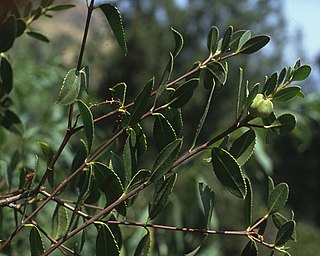
Colliguaja odorifera is a lignotuberous species of the family Euphorbiaceae. Occurrence is in portions of South America, specifically in the Chilean matorral, where it can be found on both south and north-facing slopes. Each of these slopes have different air and soil moisture levels as well as different amounts of sunlight exposure, to which the shrub is able to adapt. Its specific occurrence is noted in central Chile in the La Campana National Park and Cerro La Campana areas, where this lignotuber is found in the same forest as the endangered Chilean Wine Palm.
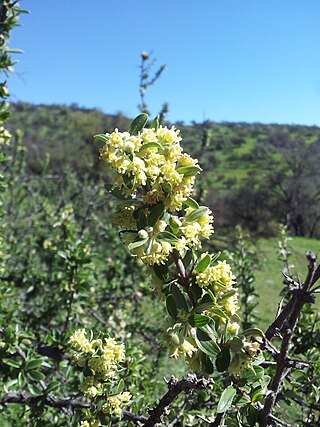
Trevoa is a genus of actinorhizal plants; these dicotyledon flora are trees or small shrubs. The genus was first proposed by Miers in 1825, but was not fully described until 1830 by Sir William Jackson Hooker. Genus members are notable for their ability to fix nitrogen. Species of this genus are generally found in the near coastal forests and arid shrubland of South America. Some species are localized in the mountains of central Chile; for example, the species Trevoa trinervis occurs in the La Campana National Park and other proximate areas of central Chile.
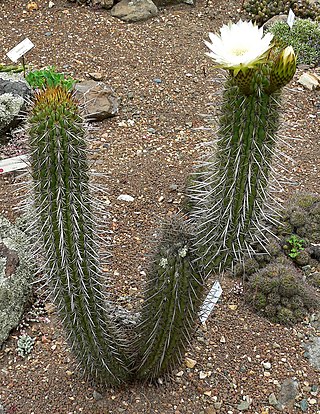
Leucostele chiloensis is a species of cactus native to South America; genus members are known as hedgehog cacti, sea-urchin cactus or Easter lily cactus.

















